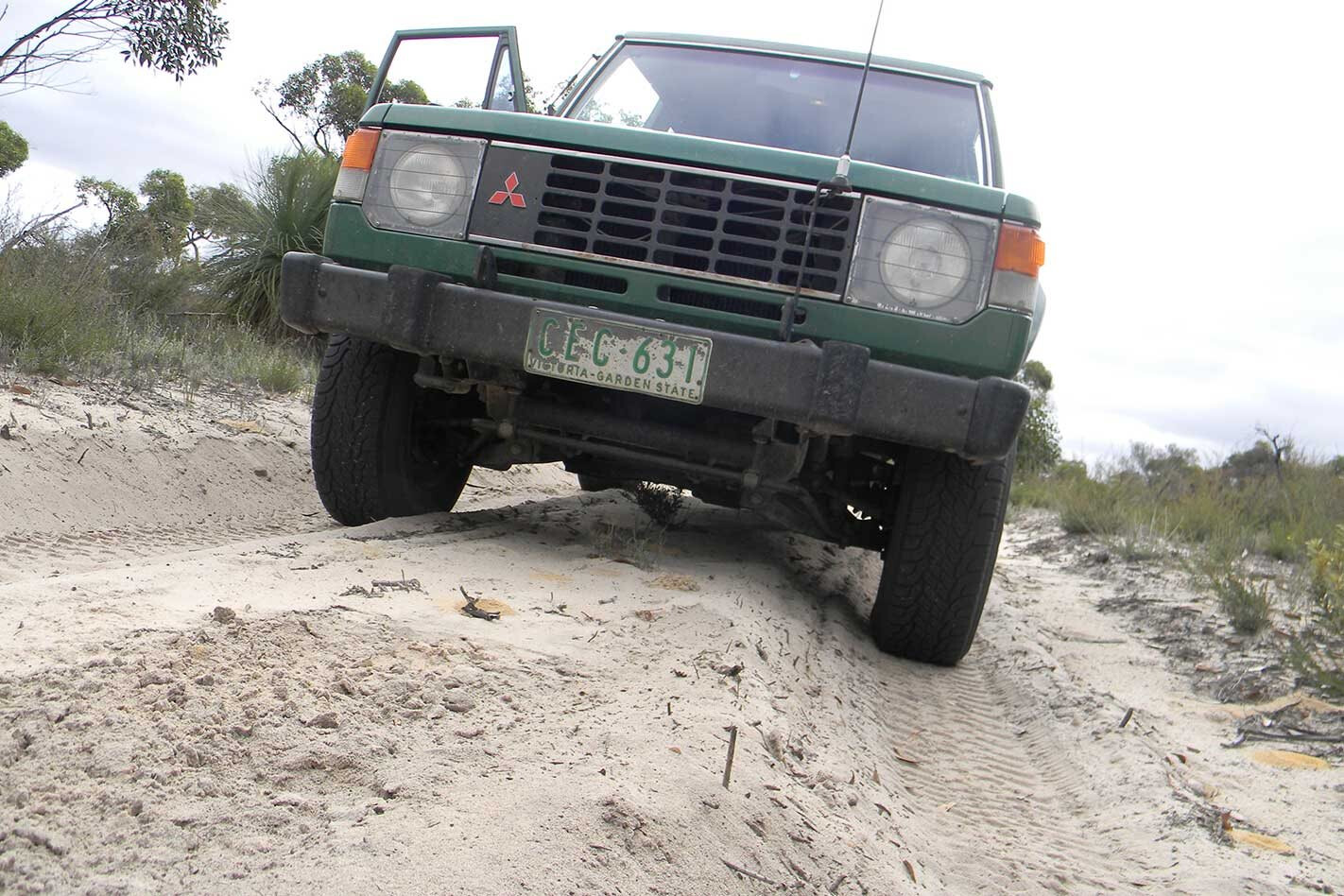
Murray-Sunset National Park provides keen adventurers with a spectacular 600km smorgasbord of sandy tracks to explore.
It’s gloriously isolated, yet this wilderness area in northwest Victoria is easy to reach – either just off the Calder Highway or by driving through the country towns of Linga and Underbool.
It takes roughly six hours to reach the park from Melbourne; an easy drive to make for those seeking an outback adventure. This is one of the largest national parks in Victoria covering a massive 6770sq km from the Murray River at Lindsay Island in the north to Pink Lakes near Underbool in the south.
Four-wheel drive clubs often use the area as practice before heading up north to the Central Australian deserts. Its environment of sand dunes, salt lakes and wide-open Mallee country is remarkably accessible, the terrain and tracks are varied and there are some fantastic campsites to enjoy at the end of each day. Throw in some fun sand hills and you have a terrific adventure playground.
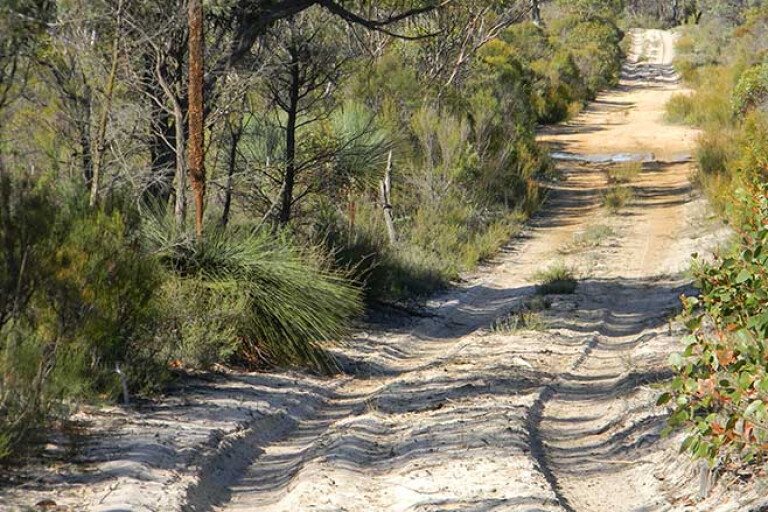
There are plenty of tracks to enjoy at remote locations including Mopoke Hut, Pheenys Track and Rocket Lake. Along the way you’ll pass almost untouched wilderness where peace and isolation are almost guaranteed. Make sure you pick up a map at the entrance to the park, though it may not be enough to see you through some of the more remote areas where GPS navigation is essential. Ensure that your tyre pressures are down once you hit the sandy tracks, and carry adequate recovery gear on board and make sure you know how to use it.
One of the prettiest places to set up camp is at Lake Crosbie Camping Ground, which sits at the edge of a shallow lake bed; one of the Pink Lakes in the area. The campground is 12km along a gravel road from Linga on the Mallee Highway, at the southern edge of the park. The amount of water in the lake depends on the time of year you visit; in spring, expect to find a carpet of desert wildflowers. If you brave the colder winter months, however, it’s likely you will have the entire place to yourself.
Pink Lakes is aptly named. The colours are due to the red pigment, carotene, which is released from algae into the water and leaves a concentrated layer of salt at the bottom of the lake. It’s a stunning spot located on the southern tip of Murray-Sunset National Park. It has an untouched landscape and remote location and is one of the most peaceful outback places to camp in Victoria. It’s one of the state’s driest regions, but it’s far from barren. In fact, it has some of the most diverse flora and fauna and a spectacular and varied landscape.
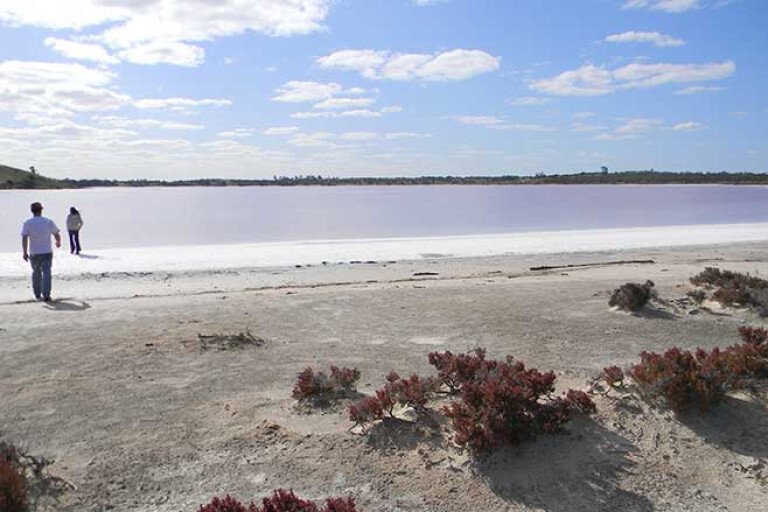
At Lake Crosbie the landscape is pristine and unspoilt, sites are spacious and roomy enough for a trailer or a couple of tents, with still enough room for a game of cricket. Each site has a fireplace and picnic table with a pit toilet located close by. There’s no drinking water available in the park so campers need to be self-sufficient, and there are no bins so whatever you take in, you take out. Also, don’t be surprised to wake each morning to the sound of birdsong – bright pink Major Mitchell cockatoos are numerous and rowdy.
The colours of the nearby lake often change on the hour depending on the cloud conditions above; in overcast weather the pink is more striking. Despite their size these lakes are pretty shallow, though it’s not advisable to walk into the water unless you want to wreck a completely good pair of shoes. By summer’s end the lakes change from deep pink to a glittering white when the water evaporates and leaves a salt crust behind.
For bushwalkers there are some great walks to enjoy in the Pink Lakes camping area. These range from an easy 45-minute walk, to overnight hikes along the Sunset Remote Walking Track. Autumn or spring are the best seasons to enjoy bushwalking as temperatures can soar past 40C in the summer months.
There are easy walks around Lake Hardy and Lake Becking, as well as the two-kilometre Kline Nature Walk which starts from the shore of Lake Crosbie. It takes in the vista of the lake and then winds inwards to the edge of the lake where you can view the relics of the salt mines including large piles of salt, dilapidated vehicles and rusting machinery.

There are information boards with stories of the salt mining era. In 1916 when the outbreak of World War I increased the demand for salt, Ebenezer Jones, the store keeper at Underbool, grabbed the opportunity to begin commercial salt harvesting at the nearby Pink Lakes. Back then the hard work was done with picks and shovels, surely a backbreaking job.
By 1922 drivers and teams of camels were brought in from Broken Hill to cart salt to the railways at Linga and Underbool. At its peak, 10,000 tonnes of salt was harvested from these lakes. Harvesting has long since stopped, except for present day campers who like to sample some of the local treasures. The area was declared a national park in 1991.
The flora and fauna is varied and abundant in and around the Pink Lakes. Look out for red kangaroos, the Murray lily (Victoria’s largest flower) and, if you’re a bird watcher, bring your binoculars as there are plenty of colourful and elusive species here to discover.
You might be lucky enough to spot Australia’s rarest bird, the Black-eared miner, which is occasionally sighted. In summer reptiles are common – lizards more than snakes, thankfully. Photographers will definitely be in their element, and for children, collecting rock salt from the lake shores is fun. Use it to make damper or store it in a container to take home as a tasty souvenir of the place.
A scenic Pioneer Drive hooks around the Pink Lakes area and is accessible to two wheel drives, though it’s the off-roading that is the real attraction here. Once you’re out of the Pink Lakes environs it is strictly 4WD territory and the scenery and tracks change constantly.
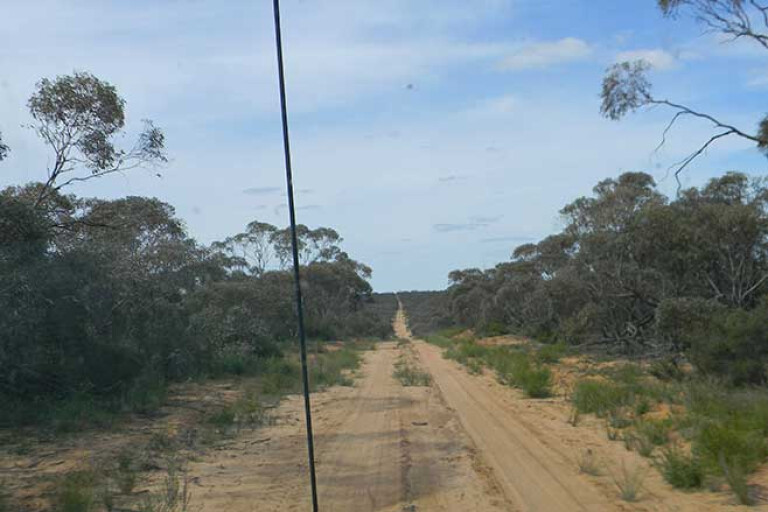
It’s important to remember that the further you go into the Murray-Sunset National Park the more crucial it is to have a good GPS for locating your position in this arid region.
The Sunset Wilderness Zone tracks cut through seemingly endless stands of Mallee trees and scrub, at times crossing steep dunes with soft sandy stretches that demand high ground clearance. It’s probably not a good idea to take trailers deep into the Sunset Wilderness Zone; better to set up camp and enjoy day trips from Lake Crosbie, Mopoke Hut or Rocket Lake.
Mopoke Hut lies just off the Mopoke Track, which runs along the western edge of the Mt Cowra Wilderness Zone. It was originally built as grazier’s quarters and, like the shearers quarters located across the other side of the park, it’s a reminder of the area’s pastoral age. Mopoke Hut Track is sandy with a few soft hills but is generally suitable for towing.
If you’re heading up to Rocket Lake from the Pink Lakes area you can head up Grub Track, Honeymoon Track and Mount Crozier Track. These link up to Underbool Track, Last Hope Track, Mopoke Track and end up at Rocket Lake.
Rocket Lake was supposedly named by the railway workers: those working near the lake fired rockets to let the workers further up the line know when it was time to knock off for the day. A small camping area has pit toilets, tables and fireplaces. The ancient dry creek-bed of Rocket Lake is just over the sand dune from the camping area.
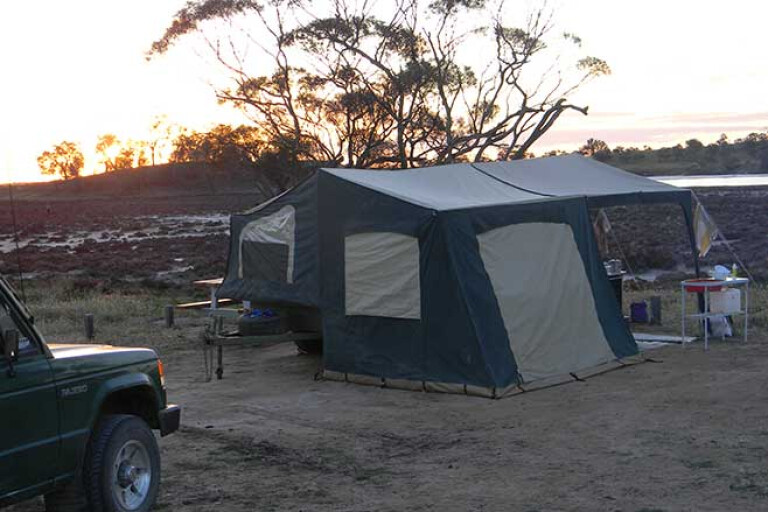
The tracks leading up to Rocket Lake are a combination of sandy dunes, corrugations and rutted soil and provide a variety of challenges. If you continue west from Rocket Lake a track will lead you to the Shearers Quarters campground. The historic self-contained cottage provides basic hostel-style accommodation for up to 14 people and was once the home of the lessee of the Sunset Pastoral Company. Bookings are essential and can be made by contacting Parks Victoria.
There are a number of routes that lead out from Rocket Lake. One of the most popular is the Nowingi Line Track which was once the railway line out to the lake. The railway line was built west from Nowingi on the Calder Highway to Rocket Lake in 1929. It was meant to help open the area up for settlement but the settlers never came and the line was never opened. It was dismantled soon afterward.
The Nowingi Line Track is an easy to moderate track all the way to the Calder. The route crosses the barely vegetated Raak Plains and passes signs of gypsum mining before coming to pastoral country once more. The track is well maintained, though it is remote country and it’s unlikely you’ll pass any other vehicles, even in peak times. So make sure you take plenty of water and be prepared in case of emergencies.

For those who want to venture further, the Border Track follows a section of the state border between Victoria and South Australia. This track is long and sandy and has lots of dunes, so a pole and sand flag are advisable to let other vehicles know of your whereabouts.
Many of these tracks are fairly easy in the dry but could become challenging if rain has fallen, particularly the Mount Jess Track closer to the Pink Lakes area. This is a steep and sandy track that leads up to Mount Kenyon and offers impressive views. Be prepared for a decent challenge, though.
If you’re travelling solo and prefer not to venture too far, Mount Crozier look-out is an excellent day trip from Lake Crosbie. An energetic climb to the summit will reward you with sprawling views of the surrounding desert with saltbush flats scattered with sand dunes. At 109 metres above sea level this is the tallest place in the park and possibly the only place you’ll get mobile phone coverage. Keep an eye out for the malleefowl on your travels, though you’d probably need to do a bit of exploring before you find these elusive birds.
Another track worth exploring is Pheeneys Track from the Ngarkat area. This track is not too daunting and there are usually a few vehicles within radio contact if you’re out and about on the weekends. Many of these tracks have high dunes, soft boggy patches and stretches of sand that seem to go on forever; little wonder Sunset Country is a great practice run for more serious desert explorers.
With its glorious isolation, sparkling salt lakes and location far from any town, this beautiful location is a place to revitalise the senses. After an adventurous day on the tracks, night times are like paradise on earth as you relax around a campfire and take in the peace and absolute silence. Lying beneath the skies in this wild and pristine environment is the best way to enjoy the ultimate outback cinema: a magical desert sunset and a dazzling array of stars.
Get the latest info on all things 4X4 Australia by signing up to our newsletter.

COMMENTS